In August 2023, a Ukrainian intelligence unit undertook a perilous mission, traveling over 600 kilometers on foot across Russian territory. Their goal was to neutralize a threat posed by the Russian Tu-22M3 bombers located at the Soltsy airfield in the Novgorod region. But how did they manage to achieve such a feat so far from the combat zones?
Follow Army Recognition on Google News at this link

A Ukrainian intelligence unit traveled over 600 kilometers on foot across Russian territory to neutralize a threat posed by Russian Tu-22M3 bombers. (Picture source: Vitaly Kuzmin/ Wikimedia/ Open Source)
Under the direction of Colonel Oleh Babii, the intelligence officers succeeded in destroying a Tu-22M3 bomber and disabling two others, thus significantly disrupting the operational capabilities of the Russian military. These long-range aircraft were extensively used by Russia to bomb Ukrainian cities, causing civilian casualties and considerable damage.
The Tupolev Tu-22M, an aircraft developed by the Soviet Union and manufactured by Tupolev, is distinguished by its role as a strategic bomber and maritime strike aircraft. Designed in the heart of the Cold War, this aircraft was a key player in the competition for aerial supremacy and strategic bombing capabilities.
Its first flight, conducted on August 30, 1969, marked the entry into a new era of strategic bombing for the Soviet Union. Introduced into service in 1972, the Tu-22M is still operational, mainly within the Russian Aerospace Forces.
The Russian Aerospace Forces are the main users of this aircraft, although it has also been historically used by the Soviet and Ukrainian air forces. Its production spanned from 1967 to 1993, with a total of 497 units built.
The role of the Tu-22M in the Soviet nuclear deterrence strategy was crucial, and it continues to play an important role in Russian military doctrine. Its versatility and ability to carry various types of armaments, including nuclear weapons, make it a leading strategic platform. The success of the Ukrainian operation is therefore crucial for destabilizing operations and Russian aerial domination in Ukraine.
However, this success came at a high price. On the return journey, Colonel Babii's reconnaissance unit was ambushed by Russian forces. During this battle, Colonel Babii covered the retreat of his comrades but was mortally wounded, succumbing to his injuries on August 30, 2023. For his courage and sacrifice, Colonel Oleh Babii was posthumously honored with the title of Hero of Ukraine and the Order of the Gold Star.
This operation not only impeded Russia's ability to conduct missile strikes on Ukrainian territory but also destabilized the functioning of airfields and long-range aviation bases. The operation highlighted the vulnerabilities in the Russian defense infrastructure and demonstrated Ukraine's ability to conduct complex and highly effective operations deep within enemy territory.
The fact that a Ukrainian sabotage team penetrated so deeply into Russian territory raises a series of questions about Russia's effectiveness in defending its strategic installations, even if they are geographically far from the Ukrainian battlefield.
This event, also marked by targeted strikes on several Russian ships in the Sea of Azov, led to a significant strategic reaction from the Russian armed forces. Faced with a direct and tangible threat, Russia was forced to review the deployment of its key military equipment in the region.
In response to these attacks, Russian aircraft stationed in the affected areas had to be repositioned. This repositioning was necessary to ensure the safety of these high-value military assets and to adapt air operations to the new threat dynamics.
Similarly, Russian ships present in the Sea of Azov also had to be withdrawn. This decision reflects an acknowledgment of increased vulnerability in this strategic maritime area. The withdrawal of the ships can be interpreted as a preventive measure to avoid further losses and to reconsider maritime strategies in a context where the risks of attacks and military engagements have intensified.
These adjustments in the deployment of Russian air and naval forces indicate a notable change in military strategy in the region. They also highlight the significant impact of military operations conducted against these assets, thus affecting Russia's operational and strategic plans.
The mission underscored the innovative and daring strategies employed by Ukrainian forces against a technologically and numerically superior adversary. This operation will undoubtedly be remembered as one of the most audacious and successful intelligence missions of the conflict.















